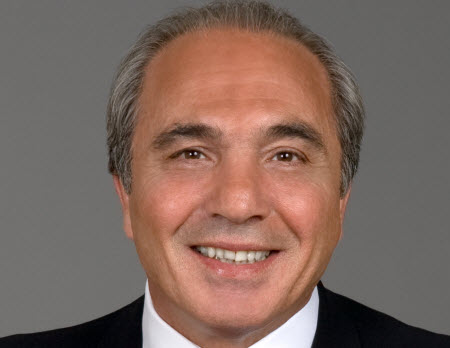From Calabria to a Cable Chairmanship

RELATED:Mediacom: 20 Years of Growth | Standing Up for Small Cable’s Interests | Mediacom: What They’re Saying | Viewpoint: Timing Was Right for Rocco
Mediacom Communications chairman and CEO Rocco Commisso’s life story is a classic tale of an immigrant who made it.
Commisso’s roots are in his birthplace of Calabria, Italy, where he was born in 1949, coming to the United States in 1962 with his parents, his older brother, Nick, and a younger sister, Italia. In an interview, Commisso said when he came to this country at 12 years old, he didn’t speak a word of English.
That changed quickly. Commisso had a knack for numbers early on and vaulted through elementary school — he said he was promoted from fifth grade to eighth grade in his first three months in the U.S. — attending high school at the prestigious Mount Saint Michael Academy in the Bronx and receiving a full scholarship to Columbia University. While at Columbia, Commisso worked nights as a supervisor at a Brooklyn Pfizer plant, going to school during the day. He also was a star soccer player at the college — he was co-captain and was invited to try out for the 1972 Olympic team. Commisso got his MBA at Columbia Business School in 1975.
FROM COLLEGE TO BANKING
Commisso’s first job after Columbia was with Chase Manhattan Bank in 1976. In 1978, he began working under Thomas Riefenheiser (later a Mediacom director), lending to the communications and entertainment sector — including the cable industry, which Commisso called his biggest break at the time.
Commisso was no stranger to hard work. He delivered pizzas as a teenager for his brother’s pizza business and in the mid-1970s, while still in graduate school, helped that same brother open a successful disco in the Bronx. Both endeavors gave him early hands-on experience in business.
Multichannel Newsletter
The smarter way to stay on top of the multichannel video marketplace. Sign up below.
Commisso helped run the disco even as he worked as a banker, but in 1981 he decided to sell his portion of the nightclub to his brother and focus on his day job. It was a good decision.
That same year, Commisso left Chase for Royal Bank of Canada, where he stayed for five years before joining Alan Gerry’s CableVision Industries in 1986 as chief financial officer. Commisso helped Gerry — who he still calls his mentor and friend — build CVI into the eighth-largest cable operator in the country before Gerry sold the business in 1995 to Time Warner Inc. for a then-record $2.8 billion.
MAPPED OUT A CABLE FUTURE
Commisso could have followed the rest of the cable herd and exited the business — the threat of impending regulation had forced several cable pioneers to sell their companies. But instead of heading for the beach, Commisso mapped out a plan to start his own cable company, Mediacom Communications. People said he was crazy (see Viewpoint, page 49), but in an eight-page business plan entitled “A Window of Opportunity,” Commisso believed the time was ripe to take advantage of attractive purchase multiples (8 to 10 times cash flow) by focusing on markets in which the larger companies had no presence or interest.
In hindsight, Commisso rightly predicted that the rate regulation of the 1992 Cable Act would “be eliminated or radically revised,” and pledged that Mediacom would have: a deliberate market focus; a flexible capital structure; would form strategic alliances for services like phone; and would have a defined exit strategy. The company adhered to those promises almost to the letter except for one: Commisso originally expected to be out of the business in five to seven years.
About 20 years later, Mediacom has grown into a powerhouse among small operators — while video subscribers have declined by about 740,000 customers since 2001, its primary service units (or PSUs, a combination of subscribers to all three of its services) have grown from 1.7 million to 2.4 million today. Mediacom’s employees, who Commisso credits for much of the company’s success, have risen from 3,200 in 2001 to 4,600 today. The company prides itself on having no major layoff s during the period, even in depressed economic times after the 2008 market crash.
A TEAM PLAYER
Commisso also has fostered loyalty among his top managers, who have been with the company for an average of 18.5 years. The longest tenured next to Commisso himself are chief financial officer Mark Stephan (20 years), executive vice president of programming and HR (and Rocco’s sister) Italia Commisso-Weinand (20 years) and senior vice president and controller Brian Walsh. The youngsters of the team: EVP of operations John Pascarelli (18 years); SVP and chief technology officer JR Walden (18 years); and SVP and general counsel Joe Young (15 years).
Commisso and Mediacom have also proudly stuck to their guns on the financing and acquisitions side. Although the company has not made a major purchase since it bought AT&T Broadband’s systems in Iowa, Georgia, Illinois and Missouri in 2001, its average acquisition cost between 1996 and 2001 was $2,155 per subscriber, compared to the industry average of $3,432 per subscriber.
EYE ON DEBT
Mediacom instead has reinvested capital in the business — including about $4.2 billion in the broadband network — and up until its successful go-private transaction in 2011, bought back its own highly undervalued stock. In that going-private transaction, Commisso bought out his longtime backer, Morris Communications.
Commisso and his team also have shown their savvy in the financing markets. Mediacom’s cost of debt at yearend 2015 was about 4.3%, the lowest in the industry.
“That’s very impressive,” Moffett Nathanson principal and senior analyst Craig Moffett said.
